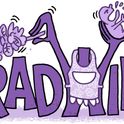We know language is dynamic and always in flux, but we often forget that so is our alphabet. I was reminded of this recently at the opening of “Alphabets Alive!”, a wonderful exhibition at the Bodleian Library in Oxford. Joining us there virtually was Yevhen Berd, a Ukrainian artist and calligrapher. His colourful contribution to the show, an AI-generated piece called Paper Cut Alphabet, features only 25 letters of the Roman alphabet: he deliberately excluded the letter Z because he sees it as a symbol of Russia’s invasion of his homeland.
When Russian tanks rolled into Ukraine in February 2022, many of them had the letter Z mysteriously spray-painted on their sides. A rapid propaganda campaign soon followed, with the Russian government mandating supporters to paint Z across billboards, put Z stickers in kindergarten and bus windows and arrange schoolchildren to line up in Z formations for drone shots. “This one simple letter disgusted me,” Berd explained to us. “It is like a swastika.”
Sometimes referred to as a “zwastika” by supporters of Ukraine, how Z became a pro-Russian symbol is uncertain. It could represent the word zapad, meaning “west”, the name given to the western divisions of the Russian army. Or it may be a military method of distinguishing internal troops to prevent friendly fire.
It is also a mystery why the Roman alphabet was chosen over the Cyrillic one used by both Russia and Ukraine; Cyrillic already has a letter with the equivalent sound in З. While use of Z as a symbol has slowed in 2023, last year it appeared widely in slogans based on the Russian word за, meaning “for”, in hybrid constructions mixing Roman and Cyrillic: citizens were urged to fight Zа, or for, victory, for Russia, for the Motherland.
Dropping or adding letters from an alphabet has been going on for centuries. We have only had 26 letters in the English alphabet for two centuries. Before then, i and j were different forms of the same letter, as were u and v (the form used depended on the position of the letter in the word). Regular s appeared only at the end of a word, “long s” (ſ ) everywhere else. Other dropped letters include ash (æ), eth (ð), thorn (þ), wynn (ƿ), yogh (ȝ) and ampersand (&, often referred to as the 27th letter because it came after Z).
There have always been people wanting to reform the English alphabet. The Irish playwright George Bernard Shaw wanted to do away with it completely, leaving £8,300 in his will expressly for the purpose of creating a new “Shavian” alphabet. There are already mutterings on social media of boycotting the letter X now that Elon Musk has commandeered it for his business ventures (and one of his sons). After all, Englsh s cmprhnsbl wtht vwls. Maybe it will survive without Xs and Zs one day.















